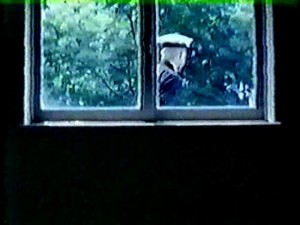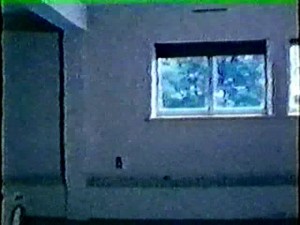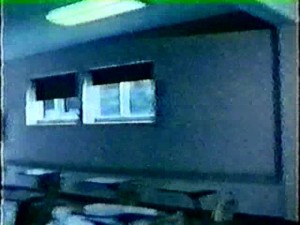From Monthly Film Bulletin , September 1976, Vol. 43, No. 512. — J.R.
Director: Michael Snow
Canada, 1969
Dist–London Film-makers Co-op /Cinegate. conceived and executed by— Michael Snow. In colour. ed–Michael Snow. sd–Darvin Studio. with— Allan Kaprow, Emmett Williams, Max Neuhaus, Terri Marsala, Donna Aughey, Joyce Wieland, Louis Commitzer, George Murphy, Dr. Gordon, Liba Bayrak, Anne Scotty, Nancy Graves, Richard Serra, John Giorno, Paul Iden, Alison Knowles, Jud Yalkut, Susan Ay-O, Mac, students in the HEP program at Farleigh Dickinson University. 1,872 ft. 52 mins.
(16 mm.)
Alternative title—Back and Forth
The camera pans back and forth across an outside wall of a classroom while a man crosses part of the field. The pan resumes inside the classroom in a fixed trajectory, revealing an asymmetrical area including part of a blackboard and a door on a far wall, two pairs of windows on the wall closer to the camera, and desks in front of the blackboard; trees, building and occasionally passing vehicles are partially visible through the doors and windows.
Throughout, one hears the sound of the camera’s mechanisms, including a loud report at the beginning and end of each pan. Various cuts emphasise that certain parts of individual pans, or entire pans, or a number in series, were filmed at different times.
As the pans gradually slow down, a man’s face appears briefly and successively in the third, fourth and second windows, then is seen washing the second, third and fourth; inside the room, a figure is seen sweeping the floor from right to left and then exiting by the door. Other figures appear in and around the desks and elsewherein the room; a woman and man play catch; a woman appears reading a book; a couple embrace; two men spar playfully in the midst of a crowd; voices are intermittently heard, and during different times of day (shown achronologically) the room is periodically seen empty. After reaching its slowest speed, the panning begins to accelerate, until the opposite sides of the room almost appear to be superimposed; eventually the image becomes a flat blur punctuated by quick flashes of light coming from the door and windows. After achieving its fastest speed, the panning reverts to an up-and-down movement that passes from the floor to the window and-back again, eventually altering its trajectory so that it first excludes the floor but encompasses part of the ceiling (including a light fixture) and then includes both, gradually slowing down. A policeman is seen peering through the window; after he leaves, the sound of a motorcycle is heard. Following the credits on a single title card, earlier segments of the film are shown in various superimpositions, utilising black-and-white footage and reverse and upside-down images in addition to the material in its previous_form, including the title card itself. Sound is eliminated shortly before this sequence ends, after which the sound of applause is heard over black leader.
A transitional work standing between the intermittent narrative concerns of Wavelength (1967) and the non-narrative concerns of La Région Centrale (1971), Michael Snow’s Back and Forth — the verbal proxy of a title designated by a graphic symbol alone — clearly differs from both in its use of the human figure. Although a man crosses the visual field in the opening shot, and people are glimpsed at intervals throughout, their presence comprises not the subject but the counterpoint of a physical process defined by the continual panning motion of the camera. Snow has noted that the use of people here and in Wavelength stems from a desire to “inhabit” the room of each film in various ways, but while their appearances in the earlier film all tended to contribute to some notion of continuity or even progression (the delivery of a bookshelf that henceforth remained on screen until the camera’s zoom bypassed it; a man who dropped dead on the floor and was subsequently acknowledged by a woman who entered the frame at a later stage), their presences here are atemporal punctuations which establish no sense of chronology or development. Similarly, the camera’s movement in the earlier film could be partially read in the narrative terms of a ‘journey’, but Back and Forth quite unambiguously resists this classification: its only discernible form of ‘progression’, apart from the increasing and decreasing speeds of the pans, is the ‘memory’ coda which recapitulates some of the fllm’s former fragments.
Snow’s own gloss on this conclusion is that “the ‘body’ of the film is very physical but it itself has its reaction which is the unstructured ‘mental’ superimpositions of the ‘coda’ “. But if we omit the psychological implications of this section, what the film essentially has to offer is a pure perceptual investigation that avoids any possibility of spectator identification, either with the people on the screen or with the camera itself. (The panning itself is much too mechanical and relentless to suggest that the spectator ‘follow’ it, any more than he or she can ‘follow’ the various activities of the people with any sustained interest.) What the film proposes instead is an examination of what happens to perception in relation to various velocities — a concern which is as basic to the actual mechanics of cinema as the early studies of Muybridge (which, conversely, placed their emphasis on the material examined, not the processes of the examination itself). And Back and Forth begins to become both interesting and exciting at precisely the point when the camera’s speed goes beyond the possibilities of human vision — a notion related to the successive 360̊ trajectories around and across a landscape in La Région Centrale, which similarly exceed human capacities. It is a concept which makes scientific and aesthetic considerations almost interchangeable; both are merely different ways of describing a foray into the unknown. And inevitably, one’s first frightened response to this endeavour may well be an association of the unknown with the familiar, so that (for instance) the rapid scannings of the four windows may begin to resemble the successive flickers of film frames, and at an even faster speed may come to suggest the repeated thrusting movements of a train with windows from right to left across the remainder of the classroom space.
Describing equally a movement between flat space and a space permitting incident, the panning brings into focus numerous factors involving ordinary perception which conventional cinema never touches upon — identifying the parameters of everyday experiences which are scarcely less central to existence than the thematic discoveries of documentary or neo-realism. Like all important innovative art, Back and Forth makes the familiar unfamiliar precisely in order to make the ‘unfamiliar’ more readily accessible and recognisable.



